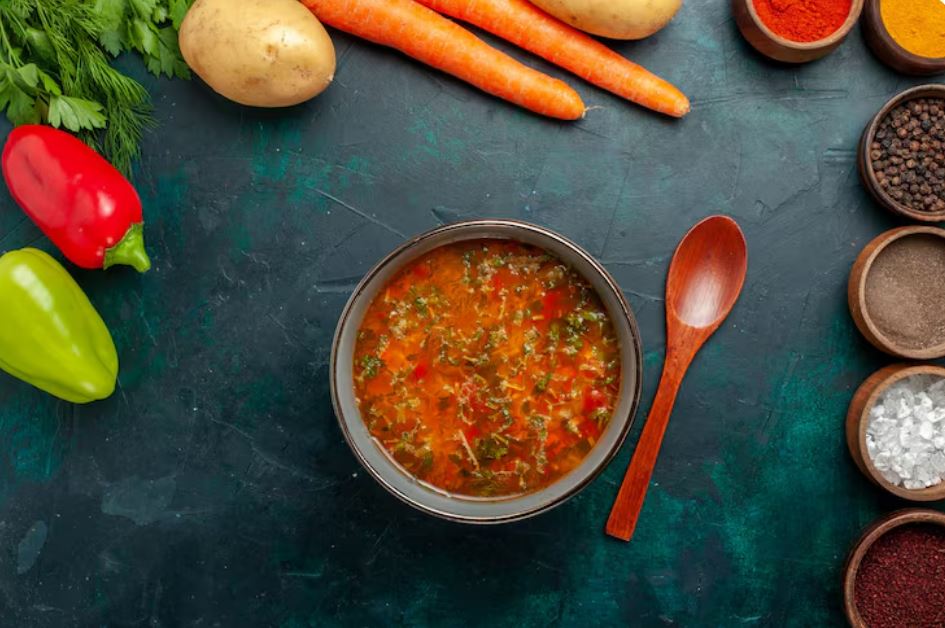
The finest vegetable soup recipe starts with a foundation that almost sounds orchestral, with each vegetable contributing a unique note to a harmony that keeps growing. A base that subtly supports the entire dish is created by beginning with celery, carrots, and onions that are slowly softened in olive oil. Similar to luring a bashful performer into the spotlight, this step is incredibly effective at bringing out the inherent sweetness of the vegetables.
The addition of curry powder, garlic, and thyme completely changes the mood. When used sparingly, curry powder functions as a signature flourish in haute couture, unquestionably necessary but only apparent to the discriminating palate. Photographers who aim for glossy culinary spreads can’t help but notice how the soup’s subtle golden hue makes it visually irresistible, as food stylists frequently point out.
Related Recipe Details
| Ingredient Highlights | Cooking Time | Notable Features |
|---|---|---|
| Onions, carrots, celery base | 55–60 mins | Balanced richness and acidity |
| Seasonal vegetables (sweet potato, zucchini, green beans) | Vegetarian, vegan, gluten-free adaptable | |
| Garlic, curry powder, thyme | Depth of flavor with subtle spice warmth | |
| Canned diced tomatoes (fire-roasted preferred) | Adds umami and natural sweetness | |
| Kidney beans or white beans | Plant protein for extra staying power | |
| Corn (fresh or frozen) | Gentle sweetness to balance savory tones | |
| Fresh greens (kale, spinach, or chard) | Boosts nutrition and color contrast | |
| Lemon juice & fresh parsley | Brightens and freshens final flavor |
Preferably fire-roasted tomatoes add a depth and acidity that is both sophisticated and homey. Expert chefs recommend cooking them for a short time before adding liquid because it intensifies the flavor and greatly minimizes any metallic undertones. Many otherwise unmemorable soups have been significantly enhanced by this one change, becoming dishes that are worth making again.
Selecting the right liquid is essential. A couple of bay leaves combined with a premium vegetable broth create a layered and comforting flavor base. Red pepper flakes add a hint of heat, just enough to be intriguing but never overpowering. Allowing the soup to simmer slowly allows the flavors to combine to create something much more than the sum of its parts, which is especially useful when making larger quantities for parties.
The versatility of this recipe is truly remarkable. Green beans add a satisfying snap, zucchini adds freshness, and sweet potatoes add earthy sweetness. In addition to improving the nutritional profile, kidney or white beans give the soup a heartiness that makes it appropriate for a full meal. This harmony of lightness and substance has made vegetable soup a quiet mainstay on movie sets and in backstage catering, where long hours require sustained energy.
Corn is still a frequently overlooked addition. Its delicate sweetness balances the bitterness of leafy greens and the tang of tomatoes. Corn consistently stood out as the ingredient that brightened the entire pot during private chef recipe testing—an effect that is surprisingly inexpensive yet aesthetically pleasing and texturally pleasing.
This recipe really comes into its own in the last act. Whether it’s chard, spinach, or kale, fresh greens are gently folded in while maintaining their vivid color. The impact of a generous squeeze of lemon juice at the end is especially inventive; it lifts all the flavors and gives the soup a lasting freshness. It’s like someone pulling back a curtain to let sunlight into the room when the lemon first touches the broth.
This soup works incredibly well for a variety of purposes. It’s nutrient-dense for health-conscious people, versatile for plant-based diets, and incredibly filling for people who just want a bowl of comfort food. It’s a recipe that has subtly transcended social and culinary boundaries; it’s been served with herbal teas at wellness retreats, served at upscale winter dinner parties, and cooked in home kitchens for unusual weeknight meals.
In terms of culture, vegetable soup is now associated with deliberate, mindful cooking rather than thrift. Restaurants in North America and Europe are experimenting with vegetable soup flights, which let customers compare regional variations such as Provençal with fennel, Japanese-inspired with miso, and Tuscan with rosemary. The industry trend of using seasonal creativity to elevate traditional dishes is reflected in these whimsical interpretations.
This increase has only been sped up by the popularity of plant-forward eating. Vegetable soup provides a blank canvas for culinary creativity for chefs and uncompromising nourishment for diners. By providing a shared cultural touchpoint and a sensory experience, the best vegetable soup recipe does more than just nourish. Like a well-fitting outfit or a well-written song, it is timeless, versatile, and incredibly fulfilling.
